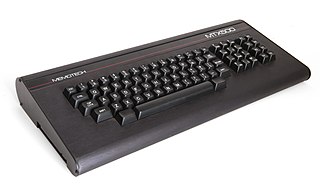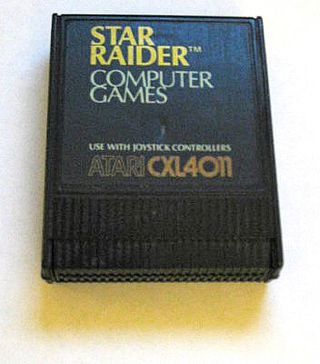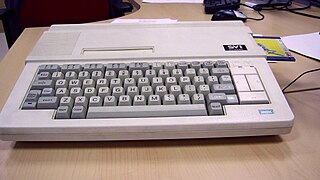
ColecoVision is a second-generation home video-game console developed by Coleco and launched in North America in August 1982. It was released a year later in Europe by CBS Electronics as the CBS ColecoVision.

MSX is a standardized home computer architecture, announced by ASCII Corporation on June 16, 1983. It was initially conceived by Microsoft as a product for the Eastern sector, and jointly marketed by Kazuhiko Nishi, the director at ASCII Corporation. Microsoft and Nishi conceived the project as an attempt to create unified standards among various home computing system manufacturers of the period, in the same fashion as the VHS standard for home video tape machines. The first MSX computer sold to the public was a Mitsubishi ML-8000, released on October 21, 1983, thus marking its official release date.

The TI-99/4 and TI-99/4A are home computers released by Texas Instruments in 1979 and 1981, respectively. Based on Texas Instruments's own TMS9900 microprocessor originally used in minicomputers, the TI-99/4 was the first 16-bit home computer. The associated TMS9918 video display controller provides color graphics and sprite support which were only comparable with those of the Atari 400 and 800 released a month later. The TI-99 series also initially competed with the Apple II and TRS-80.
MSX BASIC is a dialect of the BASIC programming language. It is an extended version of Microsoft's MBASIC Version 4.5, adding support for graphic, music, and various peripherals attached to MSX microcomputers. Generally, MSX BASIC is designed to follow GW-BASIC, released the same year for IBM PCs and clones. During the creation of MSX BASIC, effort was made to make the system flexible and expandable.
Spectravideo International Limited (SVI) was an American computer manufacturer and software house. It was originally called SpectraVision, a company founded by Harry Fox in 1981. The company produced video games and other software for the VIC-20 home computer, the Atari 2600 home video game console, and its CompuMate peripheral. Some of their own computers were compatible with the Microsoft MSX or the IBM PC.

The Tatung Einstein is an eight-bit home/personal computer produced by Taiwanese corporation Tatung, designed in Bradford, England at Tatung's research laboratories and assembled in Bridgnorth and Telford, England. It was aimed primarily at small businesses.

The SV-318 is the basic model of the Spectravideo range. It was fitted with a chiclet style keyboard, which was difficult to use, alongside a combination cursor pad/joystick. This is a disc-shaped affair with a hole in the centre; put a red plastic 'stick' in the hole and with a built-in joystick, remove the stick and it is a directional arrow pad for word processing etc. This machine also had only 16 KB of user RAM, which limited its usefulness. However, this could be expanded via an external peripheral box.

The Memotech MTX500 and MTX512 are a range of 8-bit Zilog Z80A based home computers released by the British company Memotech in 1983 and sold mainly in the UK, France, Germany and Scandinavia. Originally a manufacturer of memory add-ons for Sinclair machines, Memotech developed their own competing computer when it was perceived the expansion pack business would no longer be viable.

The Z-89 is a personal computer introduced in 1979 by Heathkit, but produced primarily by Zenith Data Systems (ZDS) in the early 1980s. It combined an updated version of the Heathkit H8 microcomputer and H19 terminal in a new case that also provided room for a built-in floppy disk on the right side of the display. Based on the Zilog Z80 microprocessor it is capable of running CP/M as well as Heathkit's own HDOS.

The IBM 3270 PC, is a personal computer developed by IBM and released in October 1983. Although its hardware is mostly identical to the IBM PC XT, the 3270 contains additional components that, in combination with software, can emulate the behavior of an IBM 3270 terminal. Therefore, it can be used both as a standalone computer, and as a terminal to a mainframe.
MSX-DOS is a discontinued disk operating system developed by Microsoft's Japan subsidiary for the 8-bit home computer standard MSX, and is a cross between MS-DOS v1.25 and CP/M-80 v2.2.

The SVI-728 is the first home computer from Spectravideo that complied fully with the MSX home computer specification. It was introduced in 1984. The design is virtually identical to that of the earlier SV-328, which did not comply fully with the MSX standard.

A ROM cartridge, usually referred to in context simply as a cartridge, cart, cassette, or card, is a replaceable part designed to be connected to a consumer electronics device such as a home computer, video game console or, to a lesser extent, electronic musical instruments.

The Spectravideo SVI-738 X'Press is an MSX1 compatible home computer manufactured by Spectravideo from 1985. Although compatible with the MSX 1.0 standard, it incorporates several extensions to the standard ; many are hardware-compatible with the MSX 2.0 standard but the system as a whole is not, leading to it being referred to as an "MSX 1.5" computer.
The SVI-838, also known as X'press 16, is the last microcomputer produced by Spectravideo. Although it was a PC clone, it had the standard sound and video coprocessors of the MSX2, making it a hybrid system. The sales were unimpressive and it is now considered a collectible.
The HB-F9P was a Sony MSX2-computer, launched in 1985. The abbreviation HB stands for Hit Bit.
The Philips NMS 8245 is a personal computer released by Philips in 1987 as part of its MSX2 line of computers.

The Philips NMS 8280 was a MSX2 computer from the Dutch company Philips, launched in 1987. The abbreviation NMS stands for New Media System. Its integrated genlock enabled professional video use, and the case allowed installation in a video rack. Intended be a video editing system, the machine was sold with a mouse. The hardware was developed by Sanyo and is based on the Sanyo MPC-27.
The Philips VG-8230 is a MSX2 standard compatible personal computer released in 1986. It was the first MSX2 machine from Philips, aimed at home users with a focus on both gaming and productivity.

The Philips VG-8235 is a Philips MSX2 compatible home computer, released in 1986 in Europe. It was developed and manufactured by the NEC.















